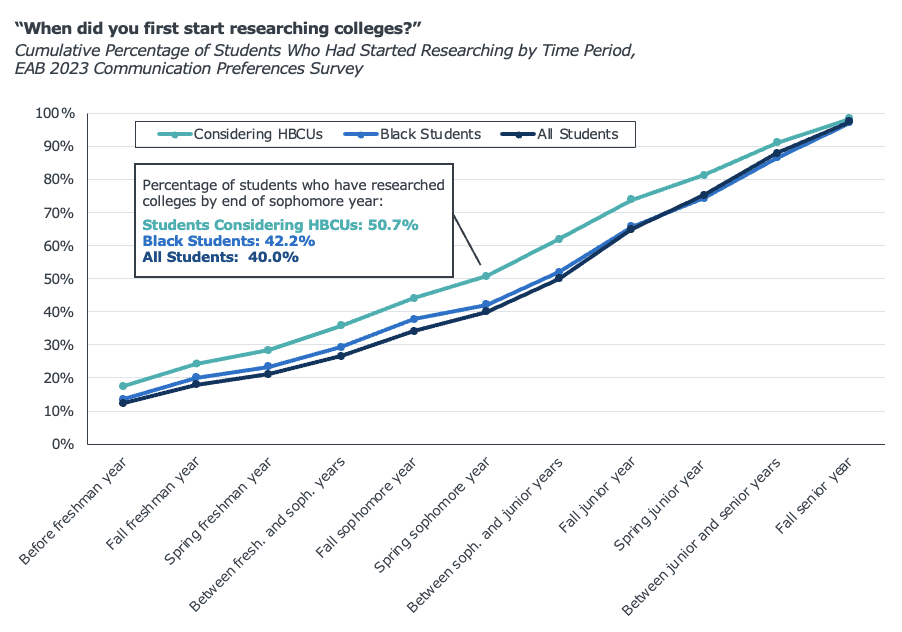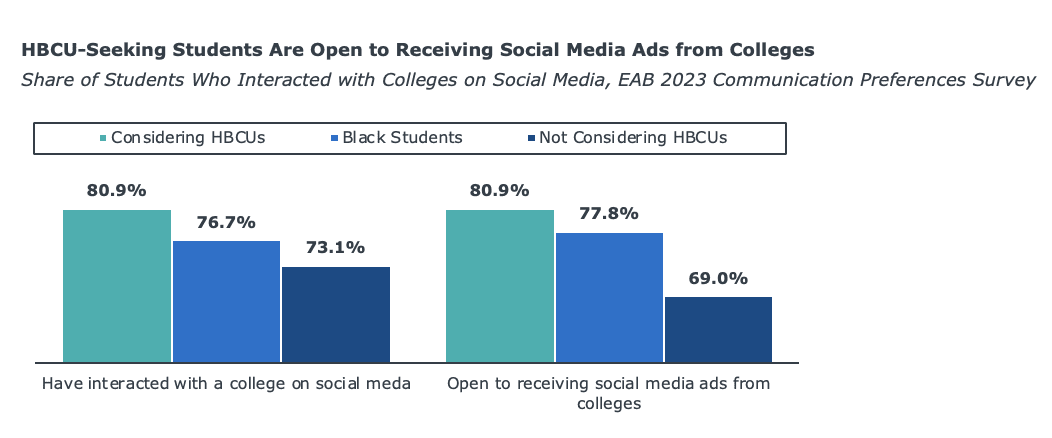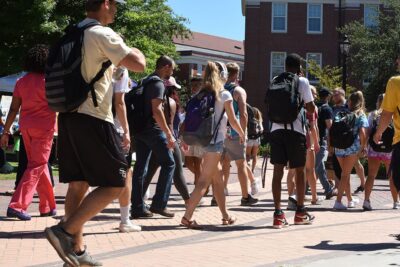How 1,000+ prospective HBCU students conducted their college search
Key insights from our 2023 Student Communication Preferences Survey
September 14, 2023, By Lorianna Mapps, Senior Consultant and Principal, Enrollment Marketing Services
The recent Supreme Court decision on affirmative action has many HBCU leaders wondering whether they’ll see an influx of enrollment for fall 2024. And while I don’t have a crystal ball to tell me exactly how the impacts of the ruling will play out, one thing is clear: this cycle will be an especially important time for HBCU enrollment leaders to double down on the messaging and marketing strategies that can help them best engage prospects.
To understand how to do that better, we can turn to data from EAB’s 2023 Student Communication Preferences Survey. As a part of that survey, we heard back from 1,070 high school students who were considering HBCUs. The responses of these “HBCU-seeking” students indicate clear trends in how students search for and evaluate colleges, which can help HBCU enrollment leaders maximize recruitment among that population.
Here are two of our top survey insights to help HBCUs better engage and recruit prospective students.
Download the Full Report From Our Survey of Prospective HBCU Students
1. Students considering HBCUs begin researching colleges earlier than their peers do
While the general student population started researching colleges later because of the pandemic, our HBCU-focused analysis revealed a fascinating trend: students considering HBCUs tend to start their college research earlier than the median for all students and for Black students.
Nearly twenty percent (17.5%) of students considering HBCUs said that they had started looking into colleges before their freshman year of high school, compared to the median of 12.4% among all students surveyed. By the end of sophomore year, 50.7% of students considering HBCUs have started college research, compared to the median of 40% among their peers.

This trend is likely related to the large role that family connections, word of mouth, and community and alumni events play in HBCU recruitment. In my work with HBCUs, the importance of family, alumni, and community connections comes up often, and several schools have mentioned that they see recruitment events as family affairs, with younger relatives welcome to attend. Because of this, students with existing ties to HBCUs may be more likely than their peers to start learning about college options in middle school or early high school. For HBCU enrollment leaders, this finding suggests that early teenage years are a key time to get in front of students to ensure you’re in their consideration set.
Recommendations
- Reach Students Early Through Events and Alumni Connections. Early outreach and brand-building play a significant role in HBCU student recruitment. Leverage in-person events, community outreach, and digital media to share your student experience.
- Encourage Family Involvement. Inviting students to attend events with their families can help build affinity with parents and start to establish connections with younger family members who may one day be researching colleges.
If You Aren’t Growing Applications, You’re Losing Enrollment
2. HBCU-seeking students prioritize belonging and experience in their college search.
The clearest—and perhaps least surprising—finding from our research was that students considering HBCUs are especially likely to prioritize belonging and community when looking for a school. When asked about the top three attributes they want in a college, HBCU prospects, as was true among the broader group of students surveyed, named affordable tuition as their top factor. However, there were significant differences among students considering HBCUs, Black students generally, and students not considering HBCUs in terms of various factors related to belonging and student experience. As shown in the chart below, students considering HBCUs were more likely to prioritize a diverse student body and “students like me on campus.” HBCU-seeking students were also more likely to prioritize strong school spirit or traditions and active Greek life, although those factors were among the top three attributes for a relatively small percentage of students.

While it’s no shock that finding a sense of belonging is a top factor that attracts students to HBCUs, this data reinforces the importance of effectively conveying that sense of the campus experience in marketing efforts. So, how can you do that most effectively? Let’s turn to the data.
When we asked students which sources of information they preferred to use in their college search, we found that YouTube and virtual tours are preferred by significant numbers of students considering HBCUs. Those channels are also more likely to be preferred by students considering HBCUs than students who aren’t—meaning they’re especially influential for HBCU-seeking students.

Our survey provides further evidence that YouTube and other social media channels are key tools in recruiting students to HBCUs: 80.9% of students considering HBCUs said that they had interacted with a college in some way on social media, compared to 73.1% of students not considering HBCUs. In addition, students considering HBCUs are significantly more open to paid social media from colleges, with 80.9% saying they’re amenable to receiving social ads from colleges compared to 69.0% among students who aren’t considering HBCUs.

Given that students considering HBCUs are especially likely to prioritize student experience as a part of their college search criteria, it makes sense that they are more likely to turn to social media channels and virtual tours to help them gain insight into student life. These findings suggest that HBCUs should aim to build a robust social media presence and virtual tour to convey their student experience.
Recommendations
- Leverage Student Testimonials and Student-Created Content. HBCU-seeking students are more likely to prioritize belonging and diversity in a college. Use student testimonials and student-created content to show the events and features that make your campus feel like a community, including campus traditions, Greek life, homecoming, and more.
- Maximize the Impact of Your Digital Ads and Virtual Tour. Pay special attention to your social media presence and virtual tour and be sure to leverage social ads to amplify your message.
As the next recruitment cycle kicks into high gear, I hope these findings will inform your strategy and position your institution for success.

More Blogs

3 ways to engage admitted students on social media

Crisis response 101 for enrollment teams
